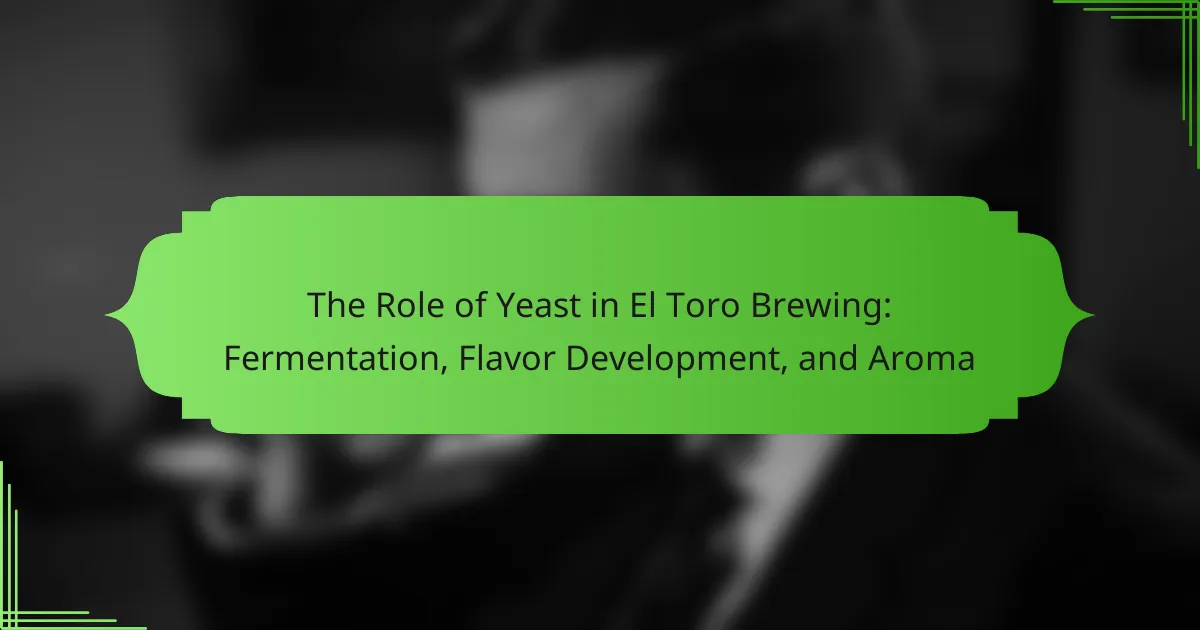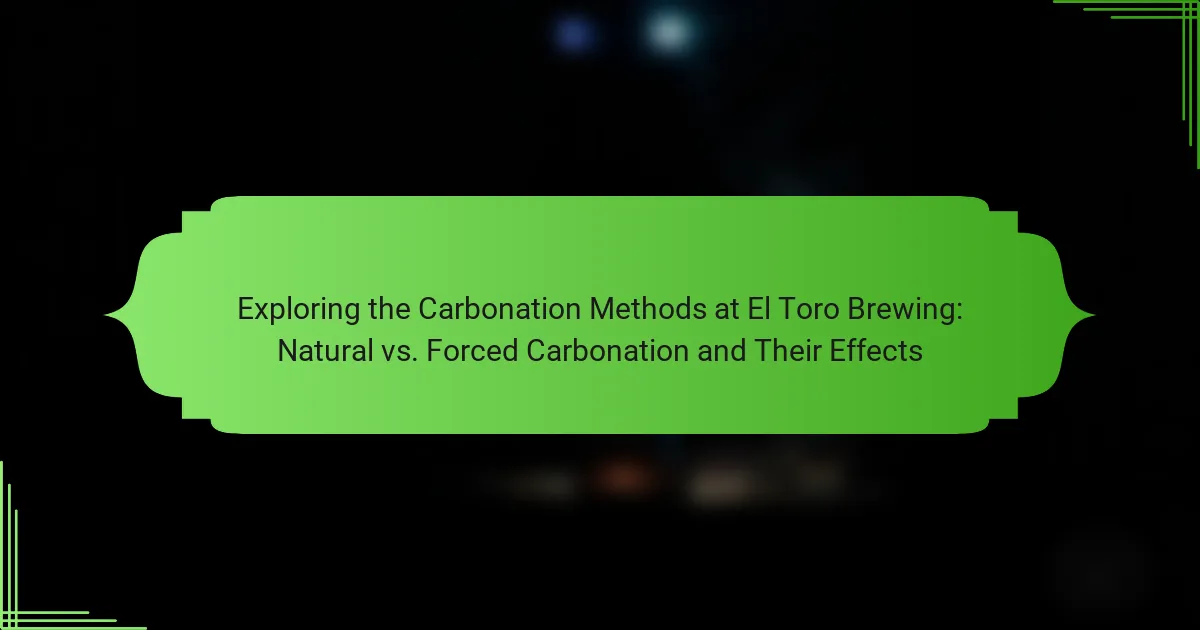Yeast is a vital entity in the brewing process at El Toro Brewing, primarily responsible for fermentation, which transforms sugars from malt into alcohol and carbon dioxide. The choice of yeast strain significantly affects the flavor and aroma profiles of the beer, producing a range of characteristics from fruity to spicy notes. During fermentation, yeast generates aromatic compounds such as esters and phenols, contributing to the overall sensory experience of the beer. Effective yeast management is essential to maintain yeast health and prevent issues like off-flavors, slow fermentation, and contamination. This article explores the critical role of yeast in fermentation, flavor development, and aroma at El Toro Brewing.

What is the role of yeast in El Toro Brewing?
Yeast plays a crucial role in El Toro Brewing by facilitating fermentation. During fermentation, yeast converts sugars from malt into alcohol and carbon dioxide. This process is essential for producing beer. The type of yeast used can significantly influence the flavor profile of the beer. Different yeast strains impart unique characteristics, such as fruity or spicy notes. Yeast also contributes to the aroma of the final product. The fermentation process typically lasts several days, allowing yeast to develop the desired flavors. Overall, yeast is fundamental to the brewing process at El Toro Brewing, impacting both taste and quality.
How does yeast contribute to the fermentation process?
Yeast contributes to the fermentation process by converting sugars into alcohol and carbon dioxide. This biological process is essential in brewing and baking. Yeast cells metabolize glucose and other fermentable sugars. As a result, they produce ethanol and CO2 as byproducts. The production of alcohol is what gives beverages their alcoholic content. The carbon dioxide generated contributes to the carbonation in drinks. Different yeast strains can impart unique flavors and aromas. This diversity enhances the overall sensory profile of the final product.
What are the key stages of fermentation involving yeast?
The key stages of fermentation involving yeast are primary fermentation, secondary fermentation, and conditioning. Primary fermentation occurs when yeast converts sugars into alcohol and carbon dioxide. This stage typically lasts from several days to a few weeks. During this time, yeast actively multiplies and ferments the sugars present in the wort.
Secondary fermentation follows, where yeast continues to ferment remaining sugars. This stage helps clarify the beverage and develop flavors. It can last from a few days to several weeks, depending on the desired outcome.
Finally, conditioning is the last stage. This stage allows the beer to mature and develop its final flavor profile. It can take weeks to months, depending on the style of beer being produced.
How does yeast metabolism affect alcohol production?
Yeast metabolism directly influences alcohol production through fermentation. During fermentation, yeast converts sugars into ethanol and carbon dioxide. This process is anaerobic, meaning it occurs in the absence of oxygen. The primary enzyme involved is zymase, which facilitates the conversion of glucose to ethanol. Different yeast strains can affect the rate and efficiency of this conversion. For example, Saccharomyces cerevisiae is commonly used in brewing due to its high ethanol yield. Studies indicate that yeast stress conditions, such as high sugar concentrations, can impact alcohol levels. Thus, yeast metabolism is crucial for determining the final alcohol content in brewed beverages.
What types of yeast are used in El Toro Brewing?
El Toro Brewing primarily uses two types of yeast: Saccharomyces cerevisiae and Brettanomyces. Saccharomyces cerevisiae is a common yeast for fermentation in many breweries. It is known for its ability to produce a clean and robust flavor profile. Brettanomyces, on the other hand, is often used for its unique characteristics. This yeast can impart complex flavors and aromas, contributing to the brewery’s distinctive offerings. The use of these yeasts allows El Toro Brewing to create a diverse range of beers.
What are the characteristics of the primary yeast strains used?
The primary yeast strains used in brewing possess distinct characteristics. Saccharomyces cerevisiae is known for its high fermentation efficiency. This strain typically ferments at warmer temperatures, producing fruity esters. Another strain, Saccharomyces pastorianus, ferments at cooler temperatures. It is often used in lager production and contributes to a clean taste profile. Brettanomyces is a unique strain that adds complex flavors and aromas. It can produce funky and earthy notes, enhancing the beer’s complexity. Each strain’s fermentation profile significantly impacts the final flavor and aroma of the beer.
How do different yeast strains influence flavor profiles?
Different yeast strains significantly influence flavor profiles in brewing. Each strain has unique characteristics that affect the production of esters and phenols. Esters contribute fruity flavors, while phenols can impart spicy or smoky notes. For example, Saccharomyces cerevisiae produces a range of fruity esters, enhancing flavors like banana and apple. Conversely, Brettanomyces can create complex, funky flavors that are often sought after in certain beer styles. The fermentation temperature also interacts with yeast strain to further modify flavor outcomes. Studies show that yeast choice can be as impactful as malt and hops in defining a beer’s overall taste. Specific yeast strains are often selected to achieve desired flavor profiles in various beer styles.
Why is yeast important for flavor development in brewing?
Yeast is crucial for flavor development in brewing because it ferments sugars into alcohol and carbon dioxide. During fermentation, yeast also produces various flavor compounds. These compounds include esters and phenols, which contribute fruity and spicy notes to the beer. Different yeast strains produce distinct flavor profiles. For instance, ale yeast tends to create more fruity flavors, while lager yeast results in cleaner profiles. The fermentation temperature also influences flavor outcomes, as higher temperatures can enhance ester production. Research has shown that yeast contributes to over 200 volatile compounds in beer. This diversity in flavor compounds is essential for creating unique and complex beer styles.
How does yeast interact with other ingredients to create flavors?
Yeast interacts with other ingredients through fermentation to create flavors. During fermentation, yeast metabolizes sugars present in the ingredients. This process produces alcohol and carbon dioxide as primary byproducts. Additionally, yeast generates various flavor compounds, including esters and phenols. Esters contribute fruity and floral notes, while phenols can impart spicy or smoky flavors. The specific strains of yeast used can influence the flavor profile significantly. For example, Belgian yeasts often produce more complex flavors compared to lager yeasts. The combination of yeast with malt, hops, and water further enhances the overall flavor experience. This interaction is crucial in brewing, as it defines the character of the final product.
What specific flavors can be attributed to yeast activity?
Yeast activity can produce a variety of specific flavors in fermentation. Common flavors include fruity esters, such as banana and apple. Yeast can also create spicy phenols, like clove and pepper. Additionally, yeast contributes to flavors of bread, toast, and caramel. These flavors result from the metabolic processes during fermentation. For example, Saccharomyces cerevisiae often produces esters at warmer fermentation temperatures. Research indicates that yeast strain selection significantly impacts flavor profiles in brewing. Thus, yeast activity is crucial for flavor development in beverages.

How does yeast impact the aroma of El Toro beers?
Yeast significantly impacts the aroma of El Toro beers. It produces various aromatic compounds during fermentation. These compounds include esters and phenols. Esters often impart fruity aromas, while phenols can contribute spicy or floral notes. The specific yeast strain used influences the aroma profile. Different strains generate distinct combinations of these compounds. For instance, certain strains may enhance citrus or tropical fruit aromas. This complexity adds depth to the overall beer experience. Thus, yeast plays a crucial role in defining the aromatic character of El Toro beers.
What aromatic compounds are produced by yeast during fermentation?
Yeast produces various aromatic compounds during fermentation, including esters, phenols, and higher alcohols. Esters, such as ethyl acetate and isoamyl acetate, contribute fruity aromas. Phenolic compounds can impart spicy or clove-like scents. Higher alcohols, like isoamyl alcohol, add complexity to the aroma profile. The specific strains of yeast used can influence the types and concentrations of these compounds. For example, Saccharomyces cerevisiae is known for producing a wide range of esters. Research shows that fermentation conditions, such as temperature and nutrient availability, also affect aromatic compound production. These compounds play a crucial role in the overall flavor and aroma of the final product in brewing.
How do these compounds enhance the overall beer experience?
Compounds produced during fermentation enhance the overall beer experience by contributing to flavor, aroma, and mouthfeel. Yeast generates esters and phenols, which create fruity and spicy notes. These flavors add complexity to the beer profile. Additionally, compounds like diacetyl can provide buttery flavors, while others contribute to a smooth mouthfeel. The balance of these compounds influences the overall drinkability. Research shows that the right yeast strain can significantly alter the sensory characteristics of beer. For instance, a study by Garde et al. (2020) demonstrates how specific yeast strains enhance the aromatic profile of ales, making them more appealing to consumers.
What role does yeast play in balancing aromas with other ingredients?
Yeast plays a critical role in balancing aromas with other ingredients during fermentation. It produces various volatile compounds that contribute to the overall aroma profile. These compounds include esters and phenols, which can enhance or mask other aromas from ingredients like hops and malt. The specific strain of yeast used can significantly influence the balance of these aromas. For example, some yeast strains produce fruity esters that complement hop aromas. Others may produce spicy phenols that add complexity to the overall aroma. The fermentation conditions, such as temperature and oxygen levels, also affect how yeast interacts with other ingredients. This interaction ultimately creates a harmonious aroma that defines the beer’s character.
How does yeast selection affect the aroma of the final product?
Yeast selection significantly influences the aroma of the final product. Different yeast strains produce varying aromatic compounds during fermentation. For example, some yeast strains generate esters, which contribute fruity aromas. Others may produce phenols, imparting spicy or clove-like scents. The specific metabolic pathways activated by each yeast strain determine the profile of these compounds. Research indicates that ale yeasts typically produce more esters than lager yeasts. This difference can lead to distinct aroma characteristics in the finished beer. Therefore, selecting the appropriate yeast strain is crucial for achieving the desired aromatic profile in brewing.
What are the differences in aroma profiles from various yeast strains?
Different yeast strains produce distinct aroma profiles during fermentation. For example, Saccharomyces cerevisiae typically generates fruity esters, such as banana and apple. In contrast, Brettanomyces strains can impart earthy and funky aromas, often described as horse blanket or barnyard. Lager yeast, like Saccharomyces pastorianus, tends to produce clean and crisp aromas with minimal fruity notes.
The aromatic compounds produced by yeast are influenced by fermentation temperature and time. Higher temperatures often enhance ester production, leading to more pronounced fruity aromas. Conversely, lower fermentation temperatures can result in cleaner profiles with fewer esters.
Research indicates that specific yeast strains can also produce unique phenolic compounds. For instance, some Belgian yeast strains are known for their spicy and clove-like aromas due to phenolic production.
Overall, the choice of yeast strain significantly affects the aroma profile of the final product. This is crucial for brewers aiming to create specific flavor and aroma characteristics in their beers.
How can brewers manipulate yeast to achieve desired aromas?
Brewers can manipulate yeast to achieve desired aromas through various techniques. They can select specific yeast strains known for producing certain aromatic compounds. For example, some strains generate fruity esters, while others produce spicy phenols. Temperature control during fermentation also influences aroma production. Higher temperatures often lead to increased ester and phenol formation.
Adjusting fermentation time can further enhance aroma profiles. Extended fermentation may allow for more complex aroma development. Additionally, brewers can incorporate different fermentation methods, such as wild fermentation, to introduce unique aromas. Nutrient additions can also impact yeast performance and aroma output.
Research indicates that yeast metabolism is crucial in aroma development. A study by J. F. M. van der Aa et al. highlights how yeast strain selection and fermentation conditions directly affect aromatic profiles in beer. This evidence supports the effectiveness of yeast manipulation in achieving desired aromas.

What are the challenges associated with yeast management in brewing?
Yeast management in brewing faces several challenges. One major challenge is maintaining yeast health and viability throughout the fermentation process. Yeast can become stressed due to temperature fluctuations, which can lead to off-flavors and fermentation failures. Another challenge is managing yeast propagation and pitching rates. Insufficient yeast pitch can result in slow fermentation and undesirable characteristics. Contamination by wild yeast or bacteria is also a significant risk, potentially spoiling the batch. Additionally, yeast autolysis can occur if yeast is left in contact with beer for too long, leading to undesirable flavors. Lastly, the variability in yeast strains can complicate consistency in flavor and aroma profiles. These factors underscore the importance of careful yeast management in brewing.
How can temperature fluctuations impact yeast performance?
Temperature fluctuations can significantly impact yeast performance. Yeast is sensitive to temperature changes, which can affect its metabolic activity. Optimal fermentation occurs within a specific temperature range, typically between 20°C to 25°C for many brewing yeasts. Deviations from this range can lead to stress responses in yeast. High temperatures may cause yeast to produce unwanted byproducts like fusel alcohols. Low temperatures can slow fermentation rates, leading to incomplete fermentation. Studies show that consistent temperatures result in more predictable fermentation outcomes. For instance, research indicates that temperature stability improves yeast health and flavor profiles in the final product.
What are the signs of yeast stress during fermentation?
Signs of yeast stress during fermentation include sluggish fermentation, off-flavors, and unusual odors. Sluggish fermentation occurs when yeast fails to convert sugars efficiently. Off-flavors can manifest as excessive esters or phenols. Unusual odors may resemble sulfur or vinegar. Additionally, yeast may produce a high level of diacetyl, which imparts a buttery flavor. These signs indicate that yeast is not functioning optimally. Monitoring these indicators is crucial for successful fermentation.
How can brewers troubleshoot yeast-related issues?
Brewers can troubleshoot yeast-related issues by assessing fermentation conditions. First, they should check the yeast viability and health. This can be done through a yeast cell count using a hemocytometer. Next, they should evaluate the fermentation temperature. Yeast performs optimally within specific temperature ranges, which vary by strain. Additionally, brewers must consider oxygen levels. Oxygen is crucial during yeast propagation but harmful during fermentation. They should also monitor the sugar content. Insufficient sugars can lead to stalled fermentation. Finally, examining the pH levels is important. Yeast thrives within a certain pH range, typically between 4.0 and 5.0. By systematically addressing these factors, brewers can effectively resolve yeast-related issues.
What best practices should be followed for yeast handling?
Best practices for yeast handling include maintaining proper sanitation and temperature control. Sanitation prevents contamination, which can spoil fermentation. Use clean equipment and surfaces to minimize microbial risks. Temperature control is essential for optimal yeast activity. Yeast thrives within specific temperature ranges, typically between 65°F to 75°F for ales and 45°F to 55°F for lagers.
Proper storage of yeast is also crucial. Store yeast in a cool, dark place to prolong its viability. Use airtight containers to prevent oxidation. Additionally, pitch the correct amount of yeast for fermentation. Under-pitching can lead to stuck fermentation, while over-pitching may result in off-flavors. Regularly check yeast viability through a viability test before use.
Monitoring fermentation progress is important. Use hydrometers or refractometers to track specific gravity changes. This helps determine when fermentation is complete. Finally, always document yeast handling practices for future reference and consistency. These practices ensure healthy fermentation and quality beer production.
How can proper sanitation improve yeast health?
Proper sanitation improves yeast health by reducing contamination risks. Contaminants can produce off-flavors and inhibit yeast activity. Clean equipment minimizes exposure to harmful bacteria and wild yeast. This allows the primary yeast strain to thrive. Healthy yeast contributes to consistent fermentation. Consistent fermentation enhances flavor and aroma profiles. Studies show that sanitation practices lead to higher yeast viability. Improved viability results in better fermentation performance.
What techniques ensure optimal yeast propagation and storage?
Optimal yeast propagation and storage techniques include maintaining appropriate temperatures and nutrient levels. Yeast thrives in temperatures between 68°F and 72°F for propagation. For storage, refrigeration at 32°F to 36°F is essential to prolong viability. Regularly monitoring pH levels helps maintain a suitable environment for yeast health. Aeration during propagation enhances yeast growth by providing necessary oxygen. Additionally, using nutrient-rich media supports robust yeast development. Properly handling yeast to avoid contamination is crucial for maintaining purity. These practices ensure consistent fermentation quality and flavor development in brewing.
The main entity of this article is yeast, specifically its role in El Toro Brewing. The article details how yeast facilitates fermentation by converting sugars into alcohol and carbon dioxide, significantly influencing the flavor and aroma profiles of the beer. It discusses the various types of yeast used, including Saccharomyces cerevisiae and Brettanomyces, and how their unique characteristics affect flavor development. Additionally, the article covers the stages of fermentation, the impact of yeast metabolism on alcohol production, and the challenges associated with yeast management in brewing, emphasizing the importance of yeast in creating distinct beer styles.


